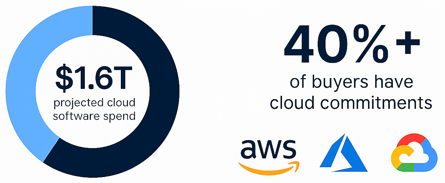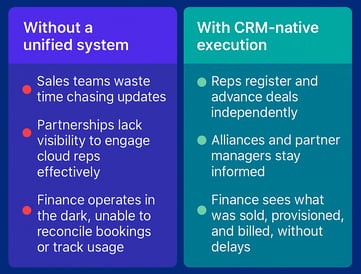Cloud marketplaces like AWS, Azure, and GCP are no longer just procurement gateways, they’re high-speed sales channels. And sales leaders are taking notice.
With cloud software spend projected to reach $1.6 trillion (Goldman Sachs) and 40% of enterprise buyers locked into multi-year cloud commitments, buyers are actively looking to spend through the cloud. Marketplaces offer speed, budget flexibility, and procurement simplicity, and sellers who meet buyers there close faster, more often.
But there’s a gap between early marketplace wins and a repeatable motion. For most sales teams, what starts as momentum often gets stuck in manual steps and cross-functional bottlenecks.

Where the Friction Begins
Teams often start strong,
✅ A buyer wants to use AWS credits
✅ A cloud rep offers to co-sell
✅ The deal closes quickly
Then come the issues,
⚠️ Deal registration gets stuck in partner portals
⚠️ Reps rely on alliances or ops to move deals forward
⚠️ Offers are delayed due to approvals or formatting
⚠️ No real-time visibility means missed follow-ups
⚠️ Pipeline is fragmented across clouds, teams, and tools
What could be a high-yield channel turns into a slow-moving, inconsistent process.
The Fix: Sell From the CRM
Sales teams need more than cloud participation, they need control and visibility.
The most effective organizations are bringing marketplace workflows inside their CRM. With a CRM-first, seller-led motion, reps can:
- Register deals to AWS ACE, Azure, or GCP from Salesforce or HubSpot
- Generate private offers from existing quotes in one click
- Track buyer engagement (offer viewed, accepted, etc.) in real time
- Tie MP-influenced revenue to pipeline, forecast, and quota
- Avoid switching between portals, spreadsheets, and Slack
This isn’t just automation, it’s alignment. Sales, partnerships, finance, and RevOps all operate from the same system of record.
When to Automate Marketplace Selling
You don’t need to automate everything. But here’s when sales leaders should make the switch,
- Marketplace deals are closing, but registration or offer creation delays are causing friction
- Buyers want to spend cloud credits (EDPs) and need fast routing
- Cloud reps are engaged, but updates fall through the cracks
- Leadership can’t track cloud revenue or see attribution in CRM
These moments signal the need to shift from reactive execution to scalable infrastructure.
How to Make Marketplace Selling Scalable
To make marketplace selling scalable and predictable,
✅ Embed co-sell registration and offer creation into CRM workflows
✅ Train reps to self-serve instead of relying on alliances or ops
✅ Track real-time status of offers and deal progression
✅ Align with RevOps to connect marketplace revenue to quotas
✅ Incentivize sellers with comp-neutral or accelerated plans
✅ Ensure entitlement and usage sync to finance for clean billing and reporting
This transforms marketplace selling from a workaround into a repeatable, high-yield motion.
Make Marketplace Selling a Team Sport
Cloud deals aren’t just sales-led, they’re cross-functional.

Leaders get a real-time view of MP-influenced pipeline and performance. Everyone moves in sync. No more missed handoffs or manual follow-ups.
How Suger Helps
Suger brings cloud marketplace selling inside your CRM, giving sales teams full control of AWS, Azure, and GCP motions, without the manual work.
✅ Deal registration and sync with AWS ACE, Azure, and GCP
✅ One-click private offer creation auto-filled from CRM quotes
✅ Real-time alerts when buyers view or accept offers
✅ Centralized visibility across sales, partnerships, and finance
✅ Reporting tied to rep quota, team performance, and cloud channel attribution
No new portals. No extra tools. No delays.
Ready to Accelerate Marketplace Sales?
Sales teams already working cloud deals can do more, with less friction.
Suger helps you turn co-sell chaos into CRM-native clarity.
👉 Book a demo and see how teams like Securiti, Teleport, and JumpCloud are leading the shift.